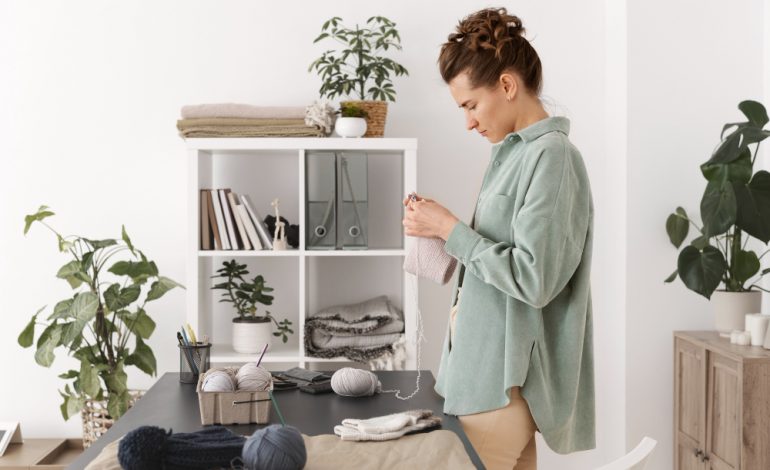
A Simple Guide to Organizing Your Home for Comfort and Convenience
Home organization is often misunderstood as little more than tidying up or making your space Instagram-worthy. But in truth, the way you arrange and manage your home has a direct effect on how you feel, how smoothly your day unfolds, and even how much mental energy you have left to devote to your well-being and relationships. Organizing isn’t about striving for a sterile showcase house—it’s about creating a supportive environment that feels comfortable, convenient, and deeply aligned with your life.
Below, we’ll explore the deeper purpose of organization, why it matters to your nervous system and overall happiness, and then dive into practical strategies for making each room of your home both functional and cozy.
Understanding the True Purpose of Home Organization
Why Comfort and Convenience Belong at the Center
When people think of getting organized, the first instinct is often to picture containers, labels, and a house free of clutter. While aesthetics have their place, the real purpose of an organized home goes beyond appearances. It’s about making your space work with you, not against you. Imagine waking up each day knowing exactly where your essentials are, moving through your routine without unnecessary delays, and returning to a home that feels like a sanctuary instead of a source of stress. That’s where true home organization delivers value: comfort and convenience.
How Your Surroundings Shape Your Mood and Productivity
Research consistently shows that cluttered environments can trigger low-level stress responses. Too much visual “noise” competes for your brain’s attention, making it harder to focus. On the other hand, a clear, thoughtfully arranged space lowers stimulation, helping you relax and concentrate. Essentially, your home environment sends constant signals to your nervous system—either adding to your stress or buffering it. This is why many people feel instantly calmer when they tidy up a room; it’s not just psychological but physiological.
Beyond Neatness: Supporting Your Lifestyle
A neat home that doesn’t align with your habits can still be frustrating. For example, if you set up a complex filing system for your mail that doesn’t match the way you actually process documents, you’ll struggle to keep it up. True organization is about tailoring systems to fit your real routines. Perhaps that means creating a small tray where you naturally throw your keys upon entry, reducing the daily panic of searching for them. Or it could mean rearranging your bedroom so natural light supports your waking rhythm. When your home complements how you already live, you gain flow, ease, and time for things that matter—whether that’s focusing on health, connecting with loved ones, or simply having the space to rest.
Common Myths That Get in the Way
One widespread myth is that home organization requires buying mountains of bins and boxes. In reality, many people already have what they need; it’s more about arranging belongings thoughtfully than investing in expensive tools. Another myth is that you must completely overhaul your entire home in a single weekend. In truth, sustainable organization is built through small, incremental changes that stick. By pacing yourself, you avoid burnout and are more likely to maintain your systems for the long haul.
The Balance of Order and Personality
It’s important to remember that an organized home doesn’t mean one stripped of personality. You’re not aiming for a perfect catalog look—you’re aiming for spaces that reflect who you are while remaining pleasant and functional. Organization is simply the framework that keeps chaos from distracting you, allowing your personal touches to shine without becoming overwhelming clutter.
The Philosophical Foundation
The ultimate goal of organizing your home isn’t about impressing visitors or hitting a magazine standard. It’s about creating an environment that quietly supports you. A well-arranged home frees up mental bandwidth and reduces obstacles in your day-to-day life. Done right, it helps you operate smoothly without extra effort, so comfort and convenience dissolve seamlessly into the background of everyday living.
Practical Approaches to Creating Functional, Cozy, and Effortlessly Organized Spaces
Now that we’ve laid the foundation, let’s get practical. Below are room-by-room strategies to help you begin creating an environment that flows naturally with your daily life.
Step One: Create a Game Plan
Before diving into organizing, pause to think about your home’s layout, the unique needs of your household, and what’s causing friction in daily routines. Make a short list of pain points: maybe it’s the pile of shoes by the door, the cluttered kitchen counter, or the messy nightstand. Tackle one zone at a time, breaking the big task into manageable steps.
The Entryway: Setting the Tone for Your Home
The entryway is often overlooked, yet it sets the tone for the entire home. Without a system, bags, shoes, and coats pile up quickly, creating instant clutter.
- Designate a drop zone: hooks for coats, a small box for mail, a basket for shoes.
- Use a bench with storage to make putting on or removing shoes easier.
- Keep this area simple and functional—it makes both arriving and leaving smoother and reduces morning stress.
The Kitchen: Streamlining the Heart of Daily Life
Cooking can feel joyful or frustrating depending on how your kitchen is organized.
- Categorize pantry items and place similar foods together.
- Use vertical storage solutions like shelf risers or hanging racks to maximize space.
- Place frequently used tools in the most accessible places (e.g., spatula near the stove, cutting board within arm’s reach).
- Minimize duplicates—you don’t need five spatulas. A streamlined kitchen makes meal prep less of a chore and more of a pleasure.
The Living Room: Balancing Relaxation and Flexibility
Your living room should strike a balance between restful family time and ease of hosting guests.
- Arrange furniture to encourage conversation while also leaving clear pathways.
- Use baskets, ottomans with hidden storage, or shelving to keep remotes, blankets, and games organized.
- Incorporate small rituals for resetting—like a five-minute evening tidy where everything returns to its place.
The Bedroom: A Sanctuary for Rest
A cluttered bedroom can impact sleep quality more than most realize.
- Keep nightstands minimal—only essentials like a lamp, book, or glass of water.
- Choose calming tones or textures that invite relaxation.
- Use under-bed storage bins, but be selective: store seasonal clothing or extra bedding, not random clutter.
- Remove items that don’t serve sleep, like piles of laundry or work documents.
The Bathroom: Small Space, Big Impact
Bathrooms often feel cramped, but smart systems can make them feel more spacious.
- Rotate towels and keep only a limited number at hand; store extras elsewhere.
- Create zones for toiletries: skincare in one container, hair products in another.
- Use clear bins or labeled drawers to minimize rummaging during rushed mornings.
Multipurpose and Work-from-Home Spaces
As more people work remotely or have rooms doing double duty, maintaining boundaries becomes vital.
- Use labeled bins or storage cubes to separate “work items” from “personal items.”
- If possible, dedicate a small corner or desk for professional tasks, even in a shared room.
- At the end of the day, reset the space so it transitions back into leisure mode.
Maintenance Habits: Keeping Organization Alive
Even the best system fails if not maintained. The goal is to make upkeep effortless.
- Try short, five-minute resets daily—returning items to their places before bed.
- Schedule seasonal reviews of belongings—what you no longer use can be donated.
- Involve everyone in the household. When all members follow the system, maintenance feels shared rather than burdensome.
Final Thoughts
Organizing your home doesn’t have to be overwhelming, expensive, or driven by perfectionism. It’s about crafting spaces that feel good, work well, and naturally support your daily life. By grounding your efforts in comfort and convenience, personalizing systems to suit your habits, and making small, sustainable changes, you create more than just a neat home—you create an environment that lowers stress, supports relaxation, and frees you to focus on the things that matter most.
When order flows seamlessly into your routines, your home becomes what it was always meant to be: a place of rest, joy, and effortless living.





